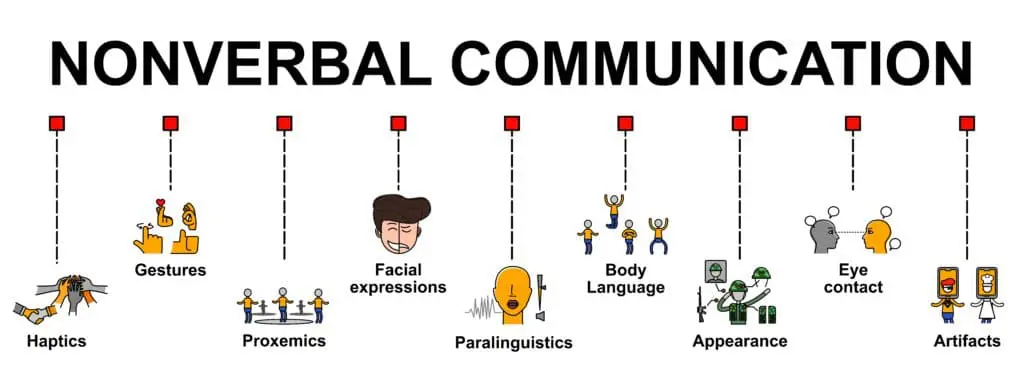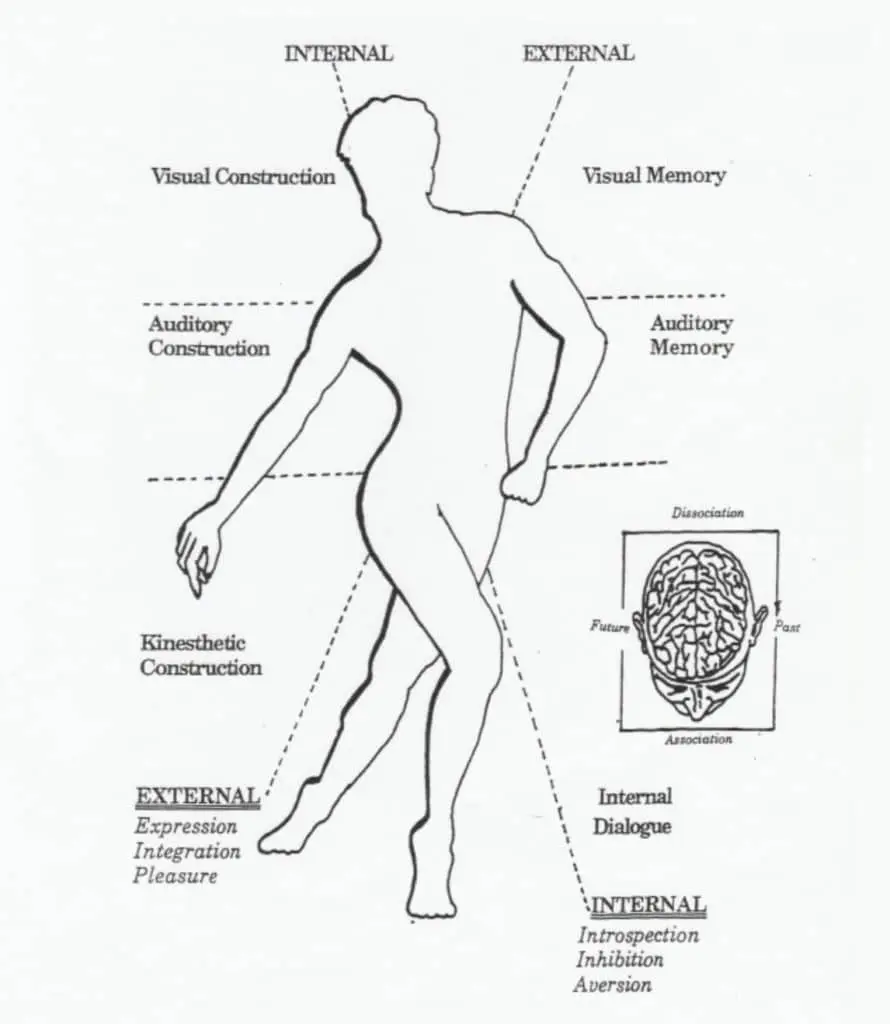Body Language and Internal Experience
Body language is your energy in motion, and this language can be discerned by those who observe keenly. As you operate in information accuracy, syncing verbal and non-verbal communication, you can remain congruent in your message being delivered.
In this article, you get an overview of body language, and how the body is applied in communication. You can gain a deeper behavioral insight into yourself and others.
Your body is a literal printout of your mind.
Your posture and body position manifests your mental attitude. This body language can also show habitually how you might have acquired such a mentality. The experiences of feeling, hearing and seeing are the information of sensory-specific brain processes.
You have processed information as you have applied your senses. This internal information processing can be observed outwardly via movements of your body. Anyone can learn how to track and interpret whole-body movements.
Preferred modes of processing can be recognized and distinguished via the movements of who you are observing. Information you gather can be applied in how you influence and persuade behavior toward your desired outcome.
As you are masterfully able to use your own non-verbal language, you’re able to gain rapport with others easily. Of course the words you choose also require a congruent corresponding language of your body, parallel to the information within you.
You become more well-rounded as a benefit of learning body language, and you grow in your ability to manifest experience. Body language awareness gives you insight into the internal shape of observed and acted experience.
You can activate the use of your whole brain and even maintain a meditative state whilst getting things done. This is a key takeaway of the latest insights into language, neurology, and behavior.

The Body Is the Mind’s Experience of Itself
As you are in a congruent mode, both input and output channels are in sync. Your body language, or analog, is congruent with your dialog.
For example, word usage matches the tone of your voice and the movement of your body, like nodding your head. Whereas an incongruent state is where simultaneous and sequential channels are not parallel with each other.
There are even expressions in the colloquial that typify that state: “out of kilter,” “off-balance,” “in a tailspin,” and so on. These are to do with your vestibular sense, which engages whole body movement and balance through your locus of control.
Medicine women and medicine men are trained to be able to track and calibrate movement. You are able to observe a behavioral expression of an internal response.
Here’s a short video going over the vestibular system of your body, for those interested in the anatomical details:
Resourceful Neurology and Physiology
You can build a resource state large enough, and activate that resourceful state within you. You hold that state constant whilst you’ve released your stuck state. The stuck state has disappeared and you are left in a resource state.
Resourceful physiology is built with parts of the whole that perhaps were not functioning, and now are integrated. You learn how to calibrate movement and you have an insight into what internal experience goes with what external behavior.
The internal milieu of experience is looked at through a window into the internal matrix of such, via external behavior.
In excellence and states of genius, a preference exists for sequencing the senses in order of feeling, then hearing, then vision. Channels that involve senses applied both internal and external, lead you to specific outcomes.
Consider the story of Paul Revere, and another infamous rider – both riding out on horseback to deliver a message. One rode in the night, waking everyone up. The other rode during the day, not waking up a soul. The message is the same, yet the submodality of the story is very different.
What can be implied when you are “woken up” with a message? Submodalities are another aspect of the analog element of communication.

Can you learn how to detect preferred behavioral manifestations of internal representations? You can very easily observe and sense happiness, or any emotion. You can sense if another is in listening mode as you’re speaking.
You can see whether someone is very playful, or not. Perhaps you notice who is in a “trance” of sorts, being associated or disassociated.
You can determine that someone could’ve been confused. You can determine a degree of alertness, integration, and certainly pleasurable states.
Body Language Excellence
In the physiology of excellence, being enduring and endearing is preferred to talking about and having an internal dialog. You’re basically being asked to stop all internal dialog and chatter.
You focus more and more on a feeling mode, and on getting things done. In the physiology of excellence, you learn to calibrate the whole body.
You observe deeper and deeper the internal structure of behavior by tracking whole-body movement patterns. Here you can see a whole body calibration diagram.

Going over the diagram, you learn how quadrants around the body are engaged in your ability to access information. What quadrants are involved when you’re coming from your memory, versus constructing things? What about whether you’re in a feeling, auditory, or visual mode?
You can learn your own pattern that you’ve been applying to communicate, process information, and organize your life. You can learn about tracking, and discern whether a particular pattern is serving you or not.
You can learn the body language patterns of others and be able to maintain rapport. A hand for instance occupies vast areas of the cerebral cortex. You can apply insight into how, via tracking body language, the hand is involved in accessing various neuro-motor circuitry.
This can give you information on whether or not sense and faculty are being applied, or not.
As the body is the mind’s experience of itself, what does neural integration look like? Are you able to recognize a positive, outcome-oriented, and resourceful state?
You can also easily observe where someone is in a state of neural inhibition. You note where protective reflexes have contracted the muscles in a mood of negativity. Similarly, body language reveals states of aversion, problem orientation, and limitation.
Hemi-Synchronization
Each brain hemisphere manages over different body parts. By learning which hemispheres are involved in what parts and movements, you have a tool to assist you to create synchronization of your brain’s hemispheres.
You have a greater amplitude of energy available as you are synchronized in this way. You learn how you possibly were applying your senses, and if there can have been a sensory system deletion in there.

You can act as you’ve been given permission. You’re aware that all memory, learning, and behavior has some positive adaptive reason behind it to have been learned – even though that may have had some secondary negative consequences.
There is definite anatomy of pleasure and of aversion. Pleasure is a state which neurologically inhibits aversive neuroanatomy and vice versa. So, this means neurologically it’s impossible to be simultaneously in a state of pleasure or joy and in a state of repulsion, disgust, avoidance, etc.
Body language allows you to learn a lot more about the senses beyond just the few senses we are taught about. Examples are your ethmoid, which is responsible for your inner magnetic directional orientation to north and south.
Your vomeronasal is another sense you have to be able to detect pheromone. Another example is your alliesthetic sense, which is involved with your ability to determine whether or not you’ve had enough of a given food or nutrient.
In studying body language, you learn how association and disassociation affect musculature and body posture. You have a toolkit to assist you to apply subliminal communication in any behavioral change work you are doing.
Integrated behavior has corresponding physiology, as does aversion. You can address aversion by giving that attention through negation. Any outcome you’ve embarked to reach can occur in balance.

What Is Communication?
Communication is the response you get back, not anything else.
Body language is a tool to achieve your intended outcome. You move forward toward a goal with a streamlined and directed approach of behavior neurally graded. Activity now synchronized between your hemispheres means you have optimal neural processing. A professional displays such neural efficiency naturally.
Output and input sensory system representations of self are experienced as a confluence of multiple channels. Your behavior shows a flow of parallel processing is occurring within. As you remain in a mode of interest and pleasure, your body language is integrated with your message.






